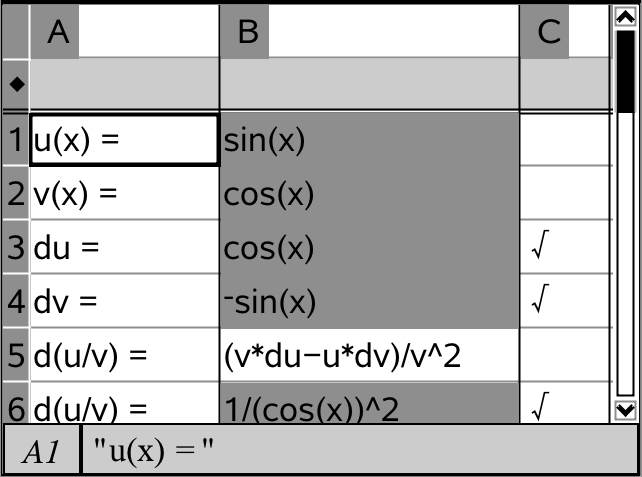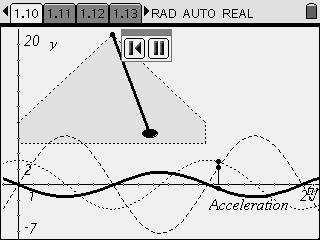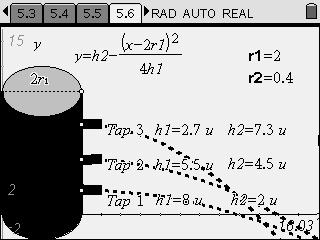Home → TI-Nspire Showcase
Calculus 1: Introducing the Differential Calculus using First Principles
Calculus 2: Introducing the Differential Calculus: Newton's Method
Calculus 3: Introducing the Differential Calculus: The Product Rule
Calculus 4: Introducing the Differential Calculus: The Quotient Rule
Calculus 5: Introducing the Differential Calculus: Composite Functions
Calculus 6: Introducing the Integral Calculus: Integration by Parts
Calculus 7: Introducing the Integral Calculus: Integration by Substitution
Calculus 8: Applications of Calculus: Simple Harmonic Motion
Calculus 11: Applications of Calculus: Introducing Maclaurin Series
Activity 1: Statistics: Asian Countries
How do we make sense of large amounts of information? This is the essential task of statistics, and two main methods present themselves: To use statistical calculations to reduce large amounts of data to small amounts of data, OR to view the information graphically.
In this activity, we use the statistical tools available to organise, to represent, and to seek to draw some conclusions from information about 25 countries in the Asia-Pacific region.
For each nation, the following facts are available:
- Country Name
- Area Total area (sq km)
- Population - est. at July 1995
- Life - Expectancy 1995 est. (years)
- GDP - GDP 1994 (US$ billions)
- GDP/caput - GDP per person 1994 est (US$)
Activity 1 Student Worksheet file
Top of Page Activity 2: Statistics: Bar of Soap
Activity 2: Statistics: Bar of SoapDo you use up the same amount of the soap in the shower each morning, or does it depend on the size of the bar of soap?
This data was collected by Rex Boggs of Glenmore State High School in Rockhampton, Queensland.
"I had a hypothesis that the daily weight of my bar of soap in my shower wasn't a linear function, the reason being that the tiny little bar of soap at the end of its life seemed to hang around for just about ever. I wanted to throw it out, but I felt I shouldn't do so until it became unusable. And that seemed to take weeks."
Activity 2 Student Worksheet file
Top of Page Activity 3: Geometry: Cones and Witches Hats
Activity 3: Geometry: Cones and Witches HatsFrom a sheet of cardboard 40 cm square, I need to make a conical witches hat for my child's party. If we assume she has a circular head of diameter 14 cm, what is the tallest hat I can make?
Assume I will make the cone by cutting a sector from a circle: what angle must I make this sector?
Activity 3 Student Worksheet file
Top of Page Activity 4: Trigonometry: Exploring the Sine Rule
Activity 4: Trigonometry: Exploring the Sine RuleTrigonometry is cool.
It uses triangles to show connections between two things that seem quite different: angles and lengths.
To start with, we use right-angled triangles to establish these relationships, but what about triangles that are not right-angled?
Activity 4 Student Worksheet file
Top of Page Activity 5: Cobweb Plots: Investigating Chaos
Activity 5: Cobweb Plots: Investigating ChaosConsider a population, say of fish in a pond. If the pond is fixed in size and limited in the amount of food it can provide, then the population of fish cannot grow unbounded.
In fact, the size of the population itself will limit the growth - as the number of fish becomes large, it will act to slow down the rate of population growth.
A simple model of such a situation over time is given by the relationship F(x) = R*x*(1 - x)
In this model, the value of "x" (the population of fish) may vary between 0 and 1, and "R" is the "growth rate" of the population. Such a "logistic equation" proves useful in studying real world populations.
This activity explores key principles of chaos theory numerically, graphically and algebraically. There is a CAS extension.
Activity 5 Student Worksheet file
Top of Page Activity 6: Calculus 1: Introducing the Differential Calculus from First Principles
Activity 6: Calculus 1: Introducing the Differential Calculus from First PrinciplesMy trip to school each day takes me 20 minutes to travel 15 miles. We would say that my average speed for this trip is 45 miles per hour.
In reality, however, I speed up and slow down continuously over that time. The differential calculus allows us to describe instantaneous rates of change rather than just averages!
In this activity, we begin with the concept of gradient between two points, which lie on the graph of a function. We learn that for many functions (like my trip to school) the gradient (or rate of change) actually changes constantly and we can calculate this rate at every point of my journey, not just at start and finish.
This activity explores first principles numerically, graphically and algebraically. It has a CAS extension which uses dynamic algebra and programming.
Activity 6 Student Worksheet file
Top of Page Activity 7: Calculus 2: Exploring Newton's Method
Activity 7: Calculus 2: Exploring Newton's MethodSuppose we wish to approximate the zeros for a function, f(x).
Newton's Method (sometimes called the Newton-Raphson Method) is an iterative method for doing this - which means that the more times we apply the method, the better our approximation should become!
This activity explores Newton's method numerically, graphically and algebraically. It has a CAS extension which uses dynamic algebra and programming.
Activity 7 Student Worksheet file
Top of Page Activity 8: Calculus 3: Introducing the Differential Calculus with CAS: The Product Rule
Activity 8: Calculus 3: Introducing the Differential Calculus with CAS: The Product RuleThe rules for differentiation for most simple functions are clear and easily learned. More difficult functions, however, can cause problems. Sometimes it helps to break the problem into smaller pieces.
This activity uses CAS to introduce and consolidate student skills and understanding of the Product Rule using a variety of tools, from computer algebra to algebraic spreadsheets to programming.
Activity 8 Student Worksheet file
Top of Page Activity 9: Calculus 4: Introducing the Differential Calculus with CAS: The Quotient Rule
Activity 9: Calculus 4: Introducing the Differential Calculus with CAS: The Quotient RuleIn this activity, we consider the case of a function which can be expressed in the form u(x)/v(x).
Once again, this activity uses CAS to introduce and consolidate student skills and understanding of the Quotient Rule using a variety of tools, from computer algebra to algebraic spreadsheets to programming.
Activity 9 Student Worksheet file
Top of Page Activity 10: Calculus 5: Introducing the Differential Calculus with CAS: Composite Functions and the Chain Rule
Activity 10: Calculus 5: Introducing the Differential Calculus with CAS: Composite Functions and the Chain RuleIn this activity, we consider the case of a function which can be expressed in the form y = f(g(x)).
Once again, this activity uses CAS to introduce and consolidate student skills and understanding of the Chain Rule using a variety of tools, from computer algebra to algebraic spreadsheets.
Activity 10 Student Worksheet file
Top of Page Activity 11: Calculus 6: Introducing the Integral Calculus with CAS: Integration by Parts
Activity 11: Calculus 6: Introducing the Integral Calculus with CAS: Integration by PartsWe have discovered that there are rules such as the Product and Quotient Rules for dealing with more difficult derivatives. But what about harder integrals?
Using CAS, algebraic spreadsheets and programming, this activity develops the method of Integration by Parts from the Product Rule, and then provides opportunities for students to explore and consolidate this important technique for integration.
Activity 11 Student Worksheet file
Top of Page Activity 12: Calculus 7: Introducing the Integral Calculus with CAS: Integration by Substitution
Activity 12: Calculus 7: Introducing the Integral Calculus with CAS: Integration by SubstitutionIn this activity we examine more difficult integrals that may be approached by using appropriate substitution - but how do we recognise these integrals, and how do we tell what to substitute?
Using CAS and algebraic spreadsheets, this activity develops the method of Integration by Substitution, and then provides opportunities for students to explore and consolidate this important technique for integration.
Activity 12 Student Worksheet file
Top of Page Activity 13: Calculus 8: Applications of Calculus: Simple Harmonic Motion
Activity 13: Calculus 8: Applications of Calculus: Simple Harmonic MotionIn this activity we investigate an important application of calculus to the physical world, simple harmonic motion. Within the context of motion on a swing, students derive the formulas, first by differentiation of the displacement/time equation and, later, by integration from the defining equation for acceleration.
Using multiple representations and CAS, this activity provides an introduction to later work on differential equations.
Activity 13 Student Worksheet file
Top of Page Activity 14: Calculus 9: Applications of Calculus: Torricelli's Law
Activity 14: Calculus 9: Applications of Calculus: Torricelli's LawTorricelli's Law describes the velocity at which water leaves a container through a (small) opening: in fact, he maintained (in 1643) that the velocity attained by the water was the same as that of water falling from the same height under the influence of gravity.
This activity uses multiple representations, algebraic programming and CAS to lead students through the derivation of Torricelli's Law and of projectile motion as applications of differential equations.
Activity 14 Student Worksheet file
Top of Page Activity 15: Calculus 10: Applications of Calculus: Projectile Motion
Activity 15: Calculus 10: Applications of Calculus: Projectile MotionProjectile Motion can be one of the best of the applications of Calculus to explore, and in this activity we not only throw balls, we shoot cannons and even shoot for basketball hoops - and learn about differential equations at the same time.
This activity uses multiple representations, algebraic programming and CAS spreadsheets to lead students through the derivation of the defining equations for projectile motion and give plenty of opportunities for practice and consolidation of both knowledge and skills.
Activity 15 Student Worksheet file
Top of Page Activity 16: Calculus 11: Applications of Calculus: Introducing Maclaurin Series
Activity 16: Calculus 11: Applications of Calculus: Introducing Maclaurin SeriesPolynomials are great, aren't they? So much easier to work with than many of those other tricky functions - especially when we are doing Calculus.
This activity uses multiple representations, interactive graphs and CAS spreadsheets to lead students through the derivation of the Maclaurin and Taylor series for approximating functions, and provides plenty of opportunities for practice and consolidation of both knowledge and skills.
Activity 16 Student Worksheet file
Top of Page

